
The Bank regulates and supervises banks and the deposit-taking activity of non-bank financial institutions under the provisions of the Banking Act 1988 and the Bank of Mauritius Act. In addition, the operations of money-changers and foreign exchange dealers are regulated and supervised in accordance with provisions of the Foreign Exchange Dealers Act 1995.
The Supervision Department of the Bank:
- processes applications for banking licences as well as authorisations for non-bank deposit-taking activity, money-changers and foreign exchange dealers;
- issues prudential regulations to be observed by authorised institutions; and
- carries out on-site and off-site surveillance of such institutions.
The safe and sound operation of institutions and the protection of depositors’ interests are the primary objectives of the Bank’s Supervision Department. As the supervisory approach has evolved, consultative meetings with the external auditors of banks being inspected have become a regular feature.
The Supervision Department has committed itself to and adopted the 25 Core Principles for effective banking supervision set by the Basel Committee.
As banks offer an increasingly diverse range of financial products, the business of banking is becoming increasingly more complex. The task of safeguarding the safety and soundness of the banking system, by ensuring that risks are properly monitored and controlled, is presenting the supervisor with new challenges each day.
Ten domestic banks and eleven offshore banks have been licensed to operate in the financial sector of Mauritius. One new offshore bank was licensed during the fiscal year 1999-00 as the eleventh offshore bank in operation in Mauritius.
Eight non-bank financial institutions are presently authorised to carry on deposit-taking activity in Mauritius. Island Leasing Co Ltd was the eighth such company to be authorised under section 13A of the Banking Act 1988 to undertake deposit-taking activity during the year under review.
During the year ended 30 June 2000, two additional money-changers and one foreign exchange dealer were authorised to carry on business in Mauritius. As a result, five money-changers and three foreign exchange dealers were in operation as at 30 June 2000.
A list of banks, non-bank deposit-taking institutions, money-changers and foreign exchange dealers is shown in Appendix VI.
Domestic Banking Sector
Banking
Activity
Total assets of domestic banks went up by 13.2 per cent to Rs110,024 million as at 30 June 2000 compared to 16.0 per cent recorded in the preceding year. The growth in assets of individual banks ranged between 5.5 per cent and 22.6 per cent. Off-balance sheet assets, consisting of acceptances, documentary credits and guarantees, grew at a lower pace of 10.3 per cent during the year and stood at Rs14,799 million at the end of June 2000.
The foreign currency operations of individual banks also increased during the year. Foreign currency assets of domestic banks stood at Rs17,040 million as at 30 June 2000 compared to Rs14,842 million as at 30 June 1999. Banks’ foreign currency assets represented 15.5 per cent of their total assets at the end of June 2000 as compared to 15.3 per cent at the end of June 1999.
As at 30 June 2000, banks carried an overall excess of foreign currency assets over liabilities amounting to Rs2,118 million for all maturities of assets and liabilities taken together. While banks had a short position of Rs2,710 million in the shorter maturity range of up to one month, excess of assets over liabilities for higher maturities over twelve months amounted to Rs4,269 million.
Shareholders’/Head Office Funds went up by 20.3 per cent to Rs10,296 million at the end of June 2000 and represented 9.4 per cent of total funds of domestic banks.
Banks’ total advances, including debenture financing, rose by 13.9 per cent to Rs69,228 million as at end-June 2000 and represented 62.9 per cent of total domestic bank assets compared to 62.5 per cent as at end-June 1999.
Banks’ total deposits went up by 11.4 per cent to Rs84,505 million at the end of June 2000. During the year ended 30 June 1999, deposits increased by 13.7 per cent. Deposits accounted for 76.8 per cent of banks’ total funds at the end of June 2000 compared to 78.0 per cent at the end of June 1999.
Investment by banks in Treasury Bills and other Government securities increased from Rs11,842 million at the end of June 1999 to Rs16,127 million at the end of June 2000. Such investments as a proportion of total assets increased from 12.2 per cent as at 30 June 1999 to 14.7 per cent as at 30 June 2000.
Banks’ investments in equity and quasi-equity of other companies amounted to Rs1,805 million as at 30 June 2000, higher by Rs474 million compared to the previous year. They accounted for 1.6 per cent of banks’ total assets as at 30 June 2000.
Institutional Developments
To improve customer services, banks have been continuously upgrading their IT infrastructures. Technology-based products such as electronic banking and plastic money, phone banking and internet banking services are being provided by the domestic banking sector.
As at 30 June 2000, 221 Automated Teller Machines (ATMs) were in operation. Some ATMs are interlinked through an on-line sharing system among banks. In June 2000, the volume and value of transactions through the use of credit cards, debit cards and similar plastic money were around 1.4 million and Rs2.0 billion, respectively.
Some banks are involved in other financial activities through subsidiaries or hold significant interests in leasing, stock brokerage and fund management entities. Some have also marked their presence on the international financial scene through foreign branches or subsidiaries.
Legislative and
Regulatory Changes
Relevant legislative changes effected during the year and regulatory measures taken to enhance the operational efficiency of banks are set out below.
Legislative Changes
The Economic Crime and Anti-Money Laundering Act 2000 was enacted by Parliament on 30 June 2000 and came into force by Proclamation on 7 July 2000.
The Act lays down measures for the prevention of Money Laundering and Economic Crime and provides for the establishment of an Economic Crime Office, the Director of which is conferred powers to require, upon the obtention of a Court order, information from or to enter and search premises of banks, deposit-taking institutions, financial institutions, money-changers and foreign exchange dealers.
Except for certain exempt transactions, payments in cash in excess of Rs350,000 or its equivalent in foreign currency are prohibited.
The Act further requires banks, deposit-taking institutions, financial institutions, money-changers and foreign exchange dealers to report to the Bank of Mauritius suspicious transactions of money laundering and casts a duty on the Bank of Mauritius to consider those reports and to refer them to the Director of the Economic Crime Office, if the reports disclose reasonable suspicion of money laundering offences.
It also empowers the Bank of Mauritius to take action against banks and deposit-taking institutions and to refer to the appropriate authority, money-changers, foreign exchange dealers and financial institutions which fail to comply with the provisions of the Act.
Section 21 of the Bank of Mauritius Act was replaced by a new section “Payments and Clearing Systems” which empowers the Bank to promote, regulate and organise the efficient and secure operation of payments and clearing systems.
Section 2 of the Banking Act 1988 was amended to replace the definition of “Director, Fiscal Investigations” by “Director-General”.
Section 6(2)(b) of the Non-Citizens (Property Restriction) Act was amended by replacing the words "or an Offshore Banking Licence" by the words "to an offshore company or an offshore bank, as the case may be". The words “Offshore Banking license” have been deleted in section 6(3) of the Act wherever they appeared.
The Banking Act 1988 and the Bank of Mauritius Act are currently being revised to modernise the legal framework for the regulation of the banking sector.
Regulatory changes
Six prudential guidelines governing the operations of commercial banks have been issued so far to supervised institutions, as follows:
(i) Guidelines on Credit Concentration Limits;
(ii) Guidelines on Risk Weighted Capital Adequacy Ratio;
(iii) Guidelines on Credit Classification for Provisioning Purposes and Income Recognition;
(iv) Guidelines on General Principles for Maintenance of Accounting and other Records and Internal Control Systems;
(v) Guidelines for the Calculation and Reporting of Foreign Exchange Exposures of Banks; and
(vi) Guidelines on Liquidity.
Non-Bank Financial Institutions
As at 30 June 1999, seven non-bank financial institutions were authorised to transact deposit-taking business under section 13A of the Banking Act 1988. During the financial year ended 30 June 2000, the licences of two of the seven institutions lapsed while three new institutions were licensed, thus bringing the total non-bank financial institutions authorised under section 13A of the Banking Act 1988 to eight.
As at 30 June 2000, the total assets of the eight non-bank financial institutions stood at Rs5,403 million, of which Rs742 million or 13.7 per cent represented their net owned funds. The total deposits collected from the public amounted to Rs738 million, that is, 13.6 per cent of the resources.
The bulk of the funds amounting to Rs4,186 million were invested in financial leases and other credit facilities.
Bank Performance
Bank performance is reviewed with respect to the following five elements:
- Risk Weighted Capital Adequacy Ratio;
- Foreign Exchange Exposure;
- Concentration of Risk and Large Exposures;
- Non-Performing Advances; and
- Profitability.
Risk Weighted Capital Adequacy
Ratio
All banks abided by the minimum risk weighted capital adequacy ratio of 10.0 per cent during the year ended 30 June 2000.

The risk weighted capital adequacy ratio of domestic banks, on average, fluctuated marginally during the year and stood at 12.3 per cent as at end-June 2000. In the course of the year, one bank resorted to a buy-back of part of its shares under the provisions of the Companies Act 1984. The ratios maintained by individual banks reflected principally differences in the nature of their operations as well as differences in their operating policies and strategies. The ratios ranged from 10.6 per cent to 61.0 per cent during the quarter ended 30 June 2000. For the banking sector as a whole, the risk weighted capital adequacy ratio stood at 12.3 per cent as at 30 June 2000, compared to 12.9 per cent a year earlier.
Table 2.1 shows the range of risk weighted capital adequacy ratios maintained by domestic banks. Chart 2.1 shows the quarterly positions of banks’ risk weighted capital adequacy ratios from end-June 1999 through end-June 2000. Chart 2.2 shows the ratio of Tier 1 and Tier 2 capital to risk weighted assets over the same period.
During the period June 1999 to June 2000, the total capital base of domestic banks increased by 4.7 per cent from Rs8,842 million to Rs9,255 million, due mainly to increases in banks’ Tier 1 Capital.
For the quarter ended June 2000, Tier 1 capital constituted 80.2 per cent of the total capital base of banks while the remaining 19.8 per cent was represented by Tier 2 Capital. Tier 1 capital for the corresponding period of the previous year was 78.6 per cent.


As a proportion of total assets, high-risk assets of domestic banks, that is, assets weighted at 100 per cent risk increased marginally from 59.4 per cent at the end of June 1999 to 59.7 per cent at the end of June 2000. Zero-risk assets increased from 22.3 per cent as at 30 June 1999 to 24.2 per cent as at 30 June 2000, mainly due to the higher levels of Government securities and Treasury Bills in banks’ portfolios.
Foreign
Exchange Exposure
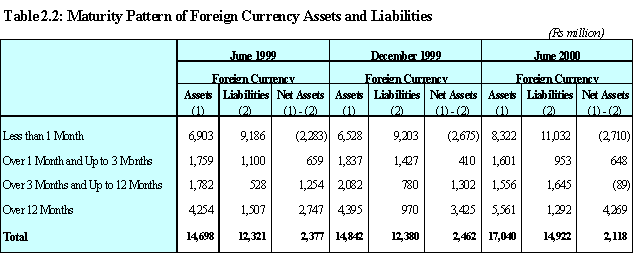
As per guidelines issued in July 1996 for the calculation and daily reporting of foreign exchange exposures, domestic banks have to ensure that their foreign exchange positions are managed in a prudential manner. As from April 1997, banks are required to observe a daily overall foreign exchange exposure limit not exceeding 15 per cent of their Tier 1 capital.
As from March 1998, the Bank of Mauritius monitors on a monthly basis the maturity pattern of banks’ foreign currency assets and liabilities. Data indicate that the banks are not unduly exposed to short-term capital mismatch and are, in general, managing their foreign currency positions in a prudential way.
Table 2.2 shows the maturity pattern of foreign currency assets and liabilities of domestic banks for the half-years ended 30 June 1999, 31 December 1999 and 30 June 2000.
Concentration of Risk and Large
Exposures
Under section 21 of the Banking Act 1988, domestic banks are required to report to the Bank of Mauritius on a quarterly basis credit facilities extended to any one customer or group of closely related customers where such facilities exceed 15 per cent of their capital base.
The aggregate credit exposure of a locally incorporated bank, together with those of its subsidiaries, associates and related companies, as defined in section 2 of the Companies Act 1984, to any entity and its related parties, shall not exceed 25 per cent of the total capital base of the bank.
The credit exposure of a subsidiary or branch of a foreign bank to an entity and its related parties, shall not exceed 50 per cent of the capital base of the subsidiary or branch.
All banks shall be subject to an aggregate large credit exposure limit. All credits of a bank that are individually over 15 per cent of the bank’s capital base, shall not in aggregate exceed 600 per cent of its capital base.
All credit shall be subject to the above regulatory concentration limits notwithstanding the level and quality of security underlying individual transactions.
Where a bank contemplates granting credit to an entity and its related parties exceeding the applicable regulatory limits, it must obtain the prior written authorisation of the Bank of Mauritius and provide such information to the Bank as may be prescribed. Such authorisation will be granted only in very exceptional circumstances and the Bank may impose such terms and conditions, as it deems necessary, including an increase in the capital adequacy ratio to be maintained.
As at 30 June 2000, total fund and non-fund based facilities, beyond the threshold of 15 per cent of a bank’s capital base, totalled Rs29,883 million, representing 36 per cent of the overall on and off-balance sheet commitments of domestic banks. The corresponding ratio in June 1999 was 32 per cent.
Non-Performing Advances
The Guidelines on Credit Classification for Provisioning Purposes and Income Recognition require that banks set aside specific provisions for advances representing more than a normal risk of loss. This determination is supported by specific minimum criteria based on the number of days the instalments of principal and/or interest are overdue.
The Bank of Mauritius expects banks to adopt adequate procedures for determining the allowance for credit losses and for income recognition, and also adequate balance in the allowance account and recognise identified credit losses on a timely basis.
The guidelines require banks to maintain a minimum general provision for credit losses of not less than one per cent in respect of their performing advances.
Credit activity being the main banking operation in Mauritius, the determination of non-performing loans and provision for bad and doubtful debts is an important tool of risk assessment and risk management for banks.
Domestic banks’ non-performing advances went up from Rs3,496 million in 1997/98 to Rs4,774 million in 1998/99 and further to Rs5,172 million in 1999/00. However, as a percentage of banks' total advances, their non-performing advances decreased from 9.0 per cent in 1998/99 to 8.1 per cent in 1999/00.
As at 30 June 2000, total provisions (inclusive of general provisions) for bad and doubtful debts amounted to Rs1,779 million compared to Rs1,834 million in the preceding year. As a proportion of banks’ total advances, the amount of outstanding provisions declined from 3.0 per cent at the end of June 1999 to 2.6 per cent at the end of June 2000.

The charge for bad and doubtful debts fell by 7.7 per cent from Rs374 million for the period ended 31 March 1999 to Rs345 million for the period ended 31 March 2000.
Table 2.3 shows the charge for bad and doubtful debts and total advances of domestic banks for the period 1996/97 through 1999/00.
Profitability
The financial year of three domestic banks ends on 30 June, that of one bank on 31 March while the remaining six banks close their accounts on 31 December. Pre-tax profits of domestic banks amounted to Rs2,070 million for 1999/00, up by 6.0 per cent or Rs117 million from those of 1998/99.

Table 2.4 shows the consolidated profit performance of all domestic banks. Their consolidated profit performance, combining the results for their various financial year-ends, is shown under the caption 1999/00 with comparative data for 1998/99.
Charts 2.3 and 2.4 depict the components of income and the components of net interest income for domestic banks, respectively, for the period 1995/96 through 1999/00.

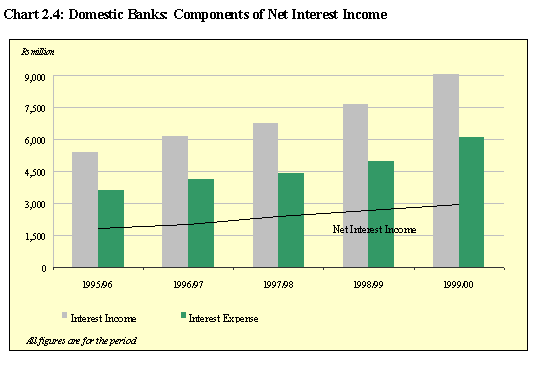
Net interest income contributed significantly to the improved profit performance of banks for the period ended 31 March 2000. Interest received on advances, placements and investments net of interest paid on deposits and borrowings amounted to Rs2,949 million for the period ended 31 March 2000 compared to Rs2,656 million for the period ended 31 March 1999.
The drop in the interest rate spread from 4.90 per cent in 1998/99 to 4.03 per cent in 1999/00 did not affect the profit performance of domestic banks.
Other income, consisting principally of profits from foreign exchange transactions and fee income, decreased by Rs69 million, or 3.9 per cent, to Rs1,698 million in 1999/00.
The profitability of banks is measured by the return on their average assets. The pre-tax return on average assets for all domestic banks declined from 2.45 per cent in 1998/99 to 2.22 per cent in 1999/00 while that of individual banks ranged between 0.13 per cent and 4.68 per cent. Five banks had a pre-tax return of over 2.0 per cent during 1999/00.

The post-tax return on average equity of domestic banks also dropped significantly from 20.1 per cent in 1998/99 to 17.6 per cent in 1999/00. As for individual banks, the post-tax return on average equity in 1999/00 ranged between 1.3 per cent and 23.5 per cent compared to the range of 4.5 per cent and 26.4 per cent in 1998/99.
Chart 2.5 shows the return on
average equity and on average assets for domestic banks for the period 1995/96
through 1999/00. Table 2.5 provides a
summary of domestic banks’ financial performance in 1998/99 and 1999/00. Chart 2.6 shows the consolidated operating
profit and the profit after tax of domestic banks for the period 1995/96
through 1999/00.
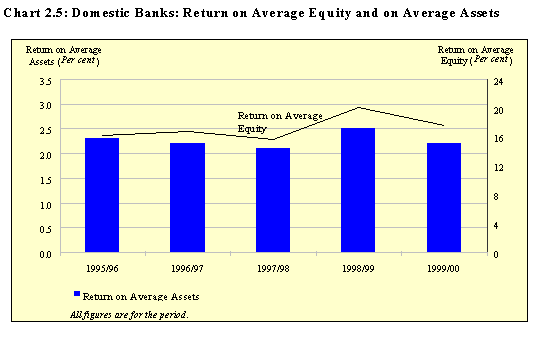
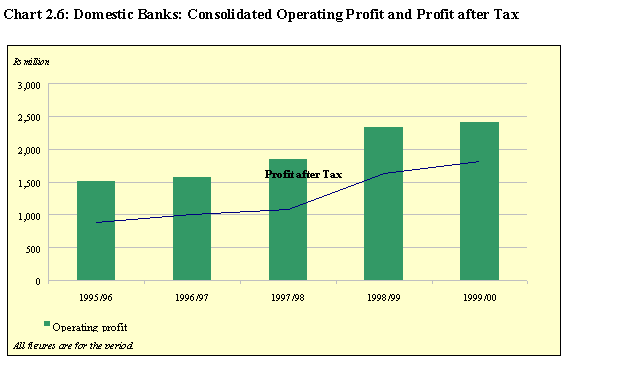
Offshore Banking Sector
The growth momentum of offshore banks was sustained in 1999/00. Total assets of offshore banks increased by 37 per cent to US$3,534 million at the end of June 2000 compared to 152 per cent registered in 1998/99.
Placements with other banks were up by US$703 million, or 43 per cent, from US$1,624 million at the end of June 1999 to US$2,327 million at the end of June 2000 and continued to constitute the major assets of offshore banks.
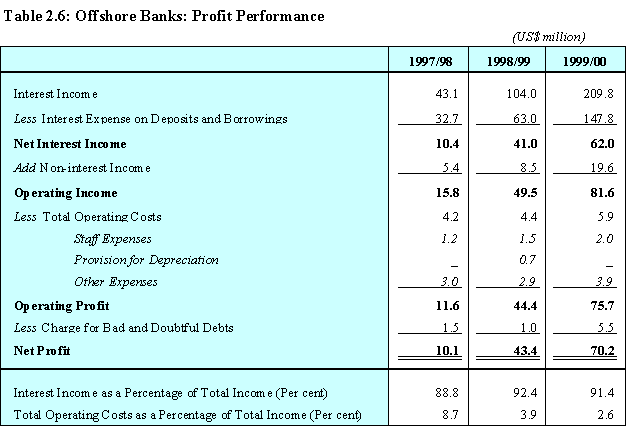
Lending to non-bank customers also increased by US$177 million, or 21 per cent, to US$1,007 million at the end of June 2000. There was, however, an increase of US$59 million in offshore banks’ investments from US$104 million as at 30 June 1999 to US$163 million as at 30 June 2000.
During the year 1999/00, the main sources of funds of offshore banks continued to be non-bank deposits (43 per cent) and borrowings from banks (39 per cent). Non-bank deposits grew by US$414 million, or 38 per cent, to US$1,505 million as at 30 June 2000. Likewise, borrowings from other banks increased by US$310 million, from US$1,068 million at the end of June 1999 to US$1,378 million at the end of June 2000.
The financial year-end of eight offshore banks is 31 December and of two offshore banks 31 March. The consolidated position of profit and loss accounts of all offshore banks, involving different financial year-ends, is referred to as 1999/00. One offshore bank started operation in January 2000.
Nine of the ten offshore banks operating during 1999/00 recorded net profits whilst a marginal net loss was suffered by the remaining one offshore bank. Aggregate net profits of the offshore banking sector rose by US$26.6 million from US$43.4 million at the end of 1998/99 to US$70.0 million at the end of 1999/00.
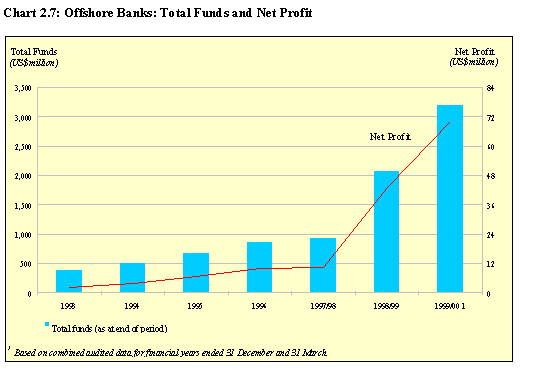
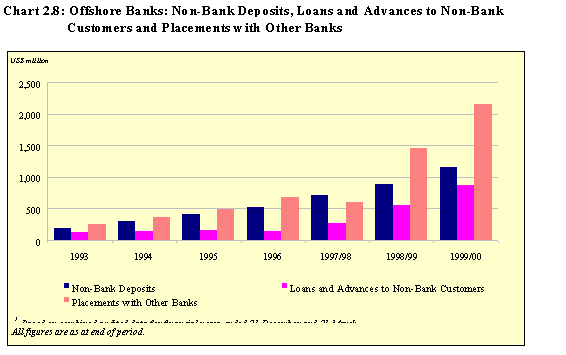
Interest earned by offshore banks on placements with other banks increased by US$10.2 million from US$77.2 million in 1998/99 to US$87.4 million in 1999/00 and accounted for 38.1 per cent of total income. Interest on loans and advances to non-bank customers increased by US$94.5 million from US$24.1 million to US$118.6 million during the same period. Interest earned on investments in 1999/00 amounted to US$3.9 million compared to US$2.2 million in 1998/99. Other income, including fees and commissions went up from US$8.5 million in 1998/99 to US$19.6 million in 1999/00 and represented 8.5 per cent of total income.
Interest paid on money market borrowings increased by US$26.2 million to US$43.7 million in 1999/00. Interest paid on deposits of non-bank customers was US$104.2 million in 1999/00 as compared to US$45.5 million in the previous year.
The aggregate pre-tax return on average total assets for the offshore banking sector was 2.92 per cent in 1999/00 compared to 3.11 per cent in 1998/99. On an individual bank basis, such return ranged from 0.52 per cent to 7.88 per cent in 1999/00.
Table 2.6 gives the profit performance of offshore banks from 1997/98 through 1999/00. Chart 2.7 shows the total funds and net profits of offshore banks for the years ended December 1993 through 1999/00. Chart 2.8 depicts non-bank customer deposits, loans and advances to non-bank customers, and placements with other banks for the years ended December 1993 through 1999/00.
Other
Supervisory Developments
A New
Capital Adequacy framework
The current Capital Adequacy Accord was issued in 1988 by the Basel Committee on Banking Supervision (BCBS) which was established in 1974 by the Central Bank Governors of G10 countries with the objective of providing a forum for international cooperation in banking supervision.
In view of the limitations of the existing Accord, the Basel Committee decided to introduce a new Capital Adequacy Framework to replace the current one. Accordingly, it published in July 1999 a consultative paper on the new Accord and called for comments from interested parties all over the world.
The Bank of Mauritius issued a copy of the document to all banks in Mauritius to seek their comments and views and forwarded to the Basel Committee the views collected, along with its own view on the matter by 31 March 2000, date at which the consultative period ended.
While the basic objective would be to continue to provide safety and soundness of the banking system, the new Accord would constitute a more comprehensive approach to addressing risks by internationally active banks. The new Accord would re-emphasise the importance of supervisory review while reaffirming emphasis on market discipline.
On the basis of the responses received at the close of the consultative period, the Basel Committee is due to issue a further consultative paper in early 2001. The Basel Committee expects the new Accord to be implemented by 2003.
Guideline
on Credit Classification for Provisioning Purposes and Income Recognition
The assessment of a bank’s financial position rests on a true and fair value of its assets (principally loans and advances). It involves analysing the credit quality, classification of the loan and provisioning. Experience has shown that the most common cause of bank failure is poor credit quality and credit-risk management. It is imperative for banks to identify and recognise deteriorations in credit quality at the right time with a view to taking corrective measures promptly.
Banks should adopt accounting principles that reflect prudential and realistic asset valuation with emphasis being placed on income recognition only when no significant uncertainty on the measurability or collectability thereof exists. In other words, income should not be overstated by banks.
In this context, the Bank of Mauritius issued on 23 November 1994 a Guideline on Income Recognition and Classification of Loans and Advances for Provisioning Purposes. With a view to requiring banks to adopt a sounder credit culture amidst continuously changing market conditions, the Bank of Mauritius issued a revised version of the abovementioned guideline now entitled “Guideline on Credit Classification for Provisioning Purposes and Income Recognition”. This Guideline, which supersedes the previous one, came into force on 1 October 1999.
Guideline
on Liquidity
A sound liquidity management policy ensures that a bank is able at all times to meet its payment obligations without incurring excessive borrowing costs and without holding excessive amounts of cash. A liquidity crisis in a bank may trigger a loss of confidence, possibly resulting in its failure.
On 21 June 2000, the Bank of Mauritius issued a Guideline on liquidity to all banks, requiring them to establish and implement a prudent liquidity management policy. According to the Guideline, every bank is required to report to the Bank of Mauritius every 6 months on the status of its liquidity policy and its effective implementation beginning with the 6 months period ending 30 June 2000.
Guideline
on Credit Concentration Limits
Diversification of risk is a key precept in banking. Experience has shown that risk concentration can result in substantial losses and even bank failure. Therefore, for prudential purposes, it is not advisable for banks to undertake large exposures while extending credit facilities to any one customer or group of closely-related customers.
On 8 April 1992, the Bank of Mauritius issued instructions to domestic banks requiring regular reporting of large credits as well as prior notification to the Bank of credits involving more than 30 per cent of net free assets (subsequently changed to capital base) of the lending bank. These instructions were amended on 1 April 1995, requiring domestic banks to obtain prior written permission of the Bank of Mauritius when aggregate credit to a customer or a related group exceeded 50 per cent of the bank’s capital base.
The Bank of Mauritius issued a new Guideline on credit concentration limits which supersedes the previous instructions given to domestic banks. The new Guideline, which came into effect on 1 May 2000, requires every bank to establish a written policy on credit concentration, setting out the principles and objectives governing the extent to which it is willing to accept credit concentration risk. The Guideline also sets out regulatory limits to be observed in the case of individual large credit exposures as well as the level of aggregate exposures.
The
Eastern and Southern African Banking Supervisors Group (ESAF)
At the regional level, the Supervision Department has continued to play an active role in the activities of the Eastern and Southern Africa (ESAF) Banking Supervisors Group.
The ESAF Banking Supervisors Group was set up in 1993 with the objective to develop a harmonised system of supervision of the member countries’ financial institutions. One of the most crucial prerequisites towards the establishment of the Group is the development of a collaborative approach of the banks in the region with the ultimate objective of enhancing the integrity of financial institutions across borders. The Executive Committee of ESAF which groups sixteen banks supervisory authorities of the region comprises supervisors from Mauritius, South Africa, Zimbabwe, Tanzania, Botswana and Zambia.
The principal issues identified and on which the Group has already started working are:
· Acting as a liaison between the Basel Committee on Banking Supervision and the regional banking supervisors.
· Harmonisation of the legal frameworks for the banking sector of the region.
· Adoption of a more uniform model for off-site analysis of bank performance.
· Development of uniform and standardised best practice programmes for on-site examinations.
· Adoption of minimum standards for the supervision of cross-border operations, including active supervisory cooperation in conducting consolidated supervision.
· Adoption of uniform international standards for published and drafted financial statements of banks.
· Sharing of resources for capacity building.
· Improved communication amongst banking supervisors in the region
While member countries are already making headway in the harmonisation of accounting and auditing standards, they have also been urged to ensure the adoption of International Accounting Standard 30, with respect to the minimum disclosures in the financial statements of banks. On the other hand, given the paramount importance of licensing standards in ensuring the setting up of banks of sound repute, member countries are currently putting their efforts together towards harmonising licensing standards in the region.
The Bank of Mauritius hosted the Fourth Senior Bank Supervisors World Bank/IMF Workshop of the ESAF Banking Supervisors Group from 14 to 18 June 1999. The Seventh Annual General Meeting of the ESAF was also held in Mauritius from 21 to 23 June 1999.
The Bank of Mauritius, in collaboration with the Bank for International Settlements (BIS) hosted a combined regional seminar and workshop on credit risk for bank supervisors of the ESAF region from 17 to 21 July 2000 in Mauritius. The Seminar was conducted by resource persons from the BIS, Deutsche Bundesbank, Dresdner Bank and New York State Banking Department, and was attended by 21 delegates from 12 countries in the ESAF region. While the main focus was on credit risk, the following topics were also dealt with during the seminar:
- The new capital adequacy framework;
- Fundamentals of derivative contracts;
- Basel core principles for effective banking supervision;
- Asset quality; and
- Market risk exposure.